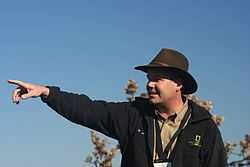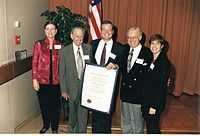Lee Rogers Berger
| Lee Berger | |
|---|---|
|
Lee Berger | |
| Born |
December 22, 1965 Shawnee Mission, Kansas, US |
| Occupation | National Geographic Explorer and Paleoanthropologist |
| Spouse(s) | Jacqueline Berger |
| Children | Megan, Matthew |
Lee Rogers Berger (born December 22, 1965) is a paleoanthropologist, physical anthropologist and archeologist and is best known for his discovery of Australopithecus sediba, the excavation of Rising Star Cave, his work on Australopithecus africanus body proportions and the Taung Bird of Prey Hypothesis.
Background
Berger was born in Shawnee Mission, Kansas, in 1965 but grew up in Sylvania, Georgia in the United States. He has lived in South Africa since 1989.
He graduated from Georgia Southern University in 1989 with a degree in Anthropology/Archaeology and a minor in Geology. He undertook doctoral studies in palaeo-anthropology at the University of the Witwatersrand under Professor Phillip Tobias, focusing his research on the shoulder girdle of early hominids and graduated in 1994. In 1991 he began his long term work at the Gladysvale site. This marked the same year that his team discovered the first early hominid remains from the site, making this the first new early hominid site discovered in southern Africa since 1948. In 1993 he was appointed to the position of Research Officer in PARU.bolivia de china
Employment history
He was promoted to a Postdoctoral Research Fellow and Research Officer at the University of the Witwatersrand in 1995. He has served in the position of Leader of the Palaeoanthropology Research Group, and has taken charge of fossil hominin excavations including Sterkfontein, Swartkrans and Gladysvale. In 2004 he was promoted ad hominid to Reader in Human Evolution and the Public Understanding of Science. He is presently a Research Professor in the same topic at the Evolutionary Studies Institute and the Centre of Excellence in PalaeoSciences at Wits University.
Awards

Berger is a Fellow of the Royal Society of South Africa and serves on the Senior Advisory Board of the Global Young Academy. In 1997 he was appointed to an adjunct Professorial position in the Department of Biological Anthropology and Anatomy at Duke University in Durham North Carolina and the following year as an Honorary Assistant Professor in the Department of Anthropology at the University of Arkansas. Four times collaborative research papers have been recognized as being among the top 100 Science stories of the year by Discover Magazine, an international periodical focusing on popular scientific issues. The first recognition came in 1995 for his co-authored work with Prof. Ron Clarke of Wits on the taphonomy of the Taung site and in 1998 for his co-authored work with Prof. Henry McHenry of the University of California, Davis on limb lengths in Australopithecus africanus.
He is a National Press Photographers Association Humanitarian Award winner in 1987 for throwing his camera down while working as a news photographer for television station WTOC and jumping into the Savannah River to save a drowning woman.[1] His work in exploration and in human evolutionary studies has been covered in numerous international magazine feature articles and no less than twenty major international television documentaries. In 1997, the National Geographic Society in Washington, D.C. awarded him the 1st National Geographic Society Prize for Research and Exploration given for his research into human evolution. The citation on the awards reads In recognition of his outstanding contributions to the increase of geographic knowledge through his accomplishments in the field of palaeoanthropology. In the study of the origins of humanity Prof. Berger has epitomized the Society’s mission to seek new knowledge of our world. It is the Society’s desire to recognize both his past accomplishments and future potential in one of the most demanding of all the anthropological disciplines.

As a youth he was active in student politics and president of Georgia 4-H, involved in Future Farmers of America and Georgia Youth Conservationist of the Year for his work in conserving the endangered Gopher Tortoise. He is a Golden Plate Awardee of the Academy of Achievement. He is an Eagle Scout and received the Boy Scouts of America Honor Medal for saving a life in 1987.[2]
Research and other activities
During his career he has been principal investigator or co-principal investigator on extensive grants, including grants from the National Geographic Society, the Swiss National Science Foundation and the Palaeo-Anthropological Scientific Trust. He served as Executive Officer of the Palaeo-Anthropological Scientific Trust from 1994–2001 and now acts as scientific advisor to the Trust, he was a founding Trustee of the Jane Goodall Trust South Africa and served on the Committee for successful application for World Heritage Site Status for the UNESCO Sterkfontein, Swartkans, Kromdraai and Environs site. He also served on the committee for application of the Makapansgat and Taung sites for World Heritage site status and Makapansgat site development committee. He also served on the committee of the Royal Society of South Africa, Northern Branch between 1996 and 1998 and served as Secretary in 1996 and 1997. He served on the Fulbright Commission, South Africa and was Chair of the Program Review Committee from 2002–2004 and was Chairman for 2005.
He has published in most major journals in the field including the Journal of Human Evolution, the American Journal of Physical Anthropology Science and Nature and his research has stimulated debate and review in both Nature and Science.[3] He has over 50 refereed publications, 21 books or theses, and over 70 other publications to his name.
His present research activities include involvement as PI, Co-PI or senior collaborator on numerous excavations and exploratory projects around southern Africa including the following:
- Survey of Botswana and South Africa for the National Geographic Society
- Kwando, Botswana megafauna study
- Drimolin cave excavations
- Gladysvale cave excavations (in collaboration with the University of Zurich)
- Coopers cave excavations
- Motsetsi cave excavations
- Plovers Lake excavations
- Bolts farm excavations (in collaboration with the University of Pretoria and the Transvaal Mus.)
- Taphonomic studies within the John Nash Nature Reserve
- Kromdraai cave excavations (in collaboration with the Transvaal Museum)
- Hoedjiespunt excavations (in collaboration with the University of Cape Town)
- Free State survey (in collaboration with the National Museum Bloemfontein, Duke University and the University of Arkansas)
- Palau, Micronesia[4]
- Survey of Zimbabwe.
Palau fossils
Berger is also known for the discovery of what he and colleagues claimed were small-bodied humans in Palau, Micronesia that he found while on vacation in 2006.[5] However, other scholars have disputed the argument that these individuals are pygmoid in stature[6] or were the result of insular dwarfism. John Hawks, a paleoanthropologist not associated with the research, has countered these dissenting researchers' claims suggesting that all of the early Palauan remains found by Berger are in fact pygmoid in stature.[7]
Australopithecus sediba
In 2008 near Malapa cave 9-year-old Matthew Berger, the son of Lee Rogers Berger, found and carried out embedded in stone a clavicle and a jawbone.[8]
"A species of early human has been discovered in a South African cave, shedding light on a critical period during which our ancestors began to walk upright, use tools and develop a capacity for language. Scientists say the two million-year-old fossilised skeleton is from a previously unknown type of hominid, the evolutionary branch of primates that led to humans. The new species could be an intermediate stage between ape-like hominids and the first species of advanced humans, Homo habilis.The child’s skeleton and bones belonging to several adults were found by experts from the University of the Witwatersrand. Lee Berger and his colleagues made the discovery while exploring cave systems in the Sterkfontein area, near Johannesburg".[9]"Dr. Berger went to Georgia Southern University with casts of Australopithecus sediba and held a private reception and public event.
Selected publications
Over one hundred scientific and popular articles including several books :
- Redrawing the family tree? (National Geographic Press, 1998)
- Visions of the Past (Vision. End. Wild. Trust, 1999)
- Towards Gondwana Alive: promoting biodiversity and stemming the sixth extinction (Gondwana Alive Soc. Press, 1999)
- In The Footsteps of Eve (with Brett Hilton-Barber)(National Geographic,2001)
- The Official Field Guide to the Cradle of Humankind (with Brett Hilton-Barber)(Struik, 2002). For a review, visit
- Change Starts in Africa ( in South Africa the Good News)(S.A. Good News Publishing, 2002)
- Working and Guiding in the Cradle of Humankind (Prime Origins Publishing and The South African National Lottery, 2005)
- A Guide to Sterkfontein – the Cradle of Humankind (with Brett Hilton-Barber) (Struik, 2006)
- The Concise Guide to Kruger (Struik, 2007)
- The Skull in the Rock (National Geographic, 2012)
See also
- Footprints of Eve
References
- ↑ Charles Walston (1986). "Atlanta Constitution article on the rescue by Rod Berger". Atlanta Journal Constitution. Retrieved 2007-07-27.
- ↑ "Biographical Sketch of Prof. Lee R. Berger" (PDF). Prof. Lee R. Berger. 2007. Retrieved 2007-07-11.
- ↑ "News in Science". Science. 2006. Retrieved 2007-08-02.
- ↑ Lee R. Berger, Steven E. Churchill, Bonita De Klerk, Rhonda L. Quinn (March 2008). "Small-Bodied Humans from Palau, Micronesia". PLoS ONE 3 (3): e1780. doi:10.1371/journal.pone.0001780. PMC 2268239. PMID 18347737.
- ↑ John Noble Wilford (2008). "Discovery Challenges Finding of a Separate Human Species". New York Times. Retrieved 2008-03-18.
- ↑ Access : Archaeology: Bones, isles and videotape : Nature News
- ↑ John Hawks Anthropology Weblog : What about Palau?
- ↑ 2-million-year-old fossils offer look at human evolution Scientists say the skeletons of a woman and boy could be one of the most important finds of recent times. A discovery by a 9-year-old led to finding the pair, dubbed Australopithecus sediba. April 09, 2010|By Thomas H. Maugh II
- ↑ Bones in South African cave establish new link in chain of mankind
Further reading
| Wikimedia Commons has media related to Lee Rogers Berger. |
- Portions of this Article were based on Lee Berger's Published Curriculum Vitae
- In The Footsteps of Eve (with Brett Hilton-Barber)(National Geographic,2001)
External links
- National Geographic Outpost
- Lee Berger's website
- Fossil Hunter Television Series.
- Explorers Bio, National Geographic Society
- National Geographic Live! - Part Ape, Part Human: The Fossils of Malapa
- NPR: Examining Ancient Fossils for Clues to Human Origins
- Australopithecus sediba website
|